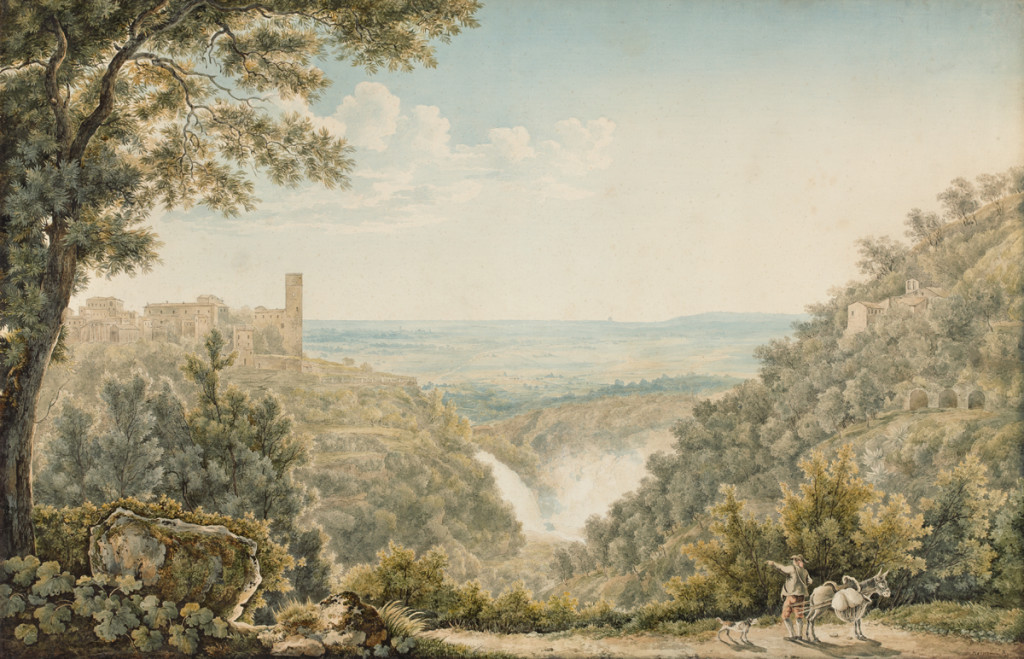Franz Keiserman
(Yverdon 1765 - 1833 Rome)
View of Tivoli, Rome 1802
Watercolour on paper, 65.5 x 101.5 cm
Signed lower right Keiserman Rome
An autograph inscription on the verso reading Vue de la ville de Tivoli et la tour de Messène avec la Campagne de Rome peinte d´après nature par F Keiserman artiste a Rome 1802
Provenance:
Private collection, Germany.
The young Swiss landscapist Franz Keiserman (Kaisermann)1 was invited to work in Rome in 1789 by his fellow countryman Abraham-Louis-Rodolphe Ducros (1748-1810), a talented and successful watercolourist. Keiserman was to work as an assistant to Ducros in his busy studio – an arrangement designed to benefit both parties. However Keiserman broke off the working relationship in 1792 and set up a studio of his own. Records show that he was in Naples in 1795 and also visited Sicily. While in Naples he came into contact with Jakob Philipp Hackert (1737-1825). Hackert had been appointed official court painter by the Bourbon king of Naples, Ferdinand IV, in 1786.
Keiserman settled permanently in Rome in 1798. He lived and worked in the Palazzetto dei Borgognoni on the Piazza di Spagna. He quickly made a name for himself in local artistic circles. Much of his patronage came from visiting collectors on the Grand Tour for whom Rome and Naples were essential stops. On their return from their travels, Grand Tourists would advertise their freshly acquired experiences of Italy by displaying views of the important cultural sites they had visited. Keiserman’s work attracted patrons like Frederick IV, Duke of Sachsen-Gotha-Altenburg; Prince Volkonskij; Crown Prince Gustavus of Sweden; Camillo Borghese; Stratford Canning, the British ambassador to the Ottoman Empire; and Elizabeth Cavendish, Duchess of Devonshire.
Keiserman is known to have employed the young artist Bartolomeo Pinelli (1781-1835) around 1800 to supply the staffage figures for his landscapes. It is reasonable to assume that Pinelli was also responsible for the figures in the present landscape view of Tivoli.2 The collaboration proved fruitful but ended in 1809, although the two remained in close contact. Records show that Franz Knébel the Elder (1789-1822), one of Keiserman’s cousins, was working for him by 1806. However, on Knébel’s early death Keiserman invited a second relative, his cousin, Franz Knébel the Younger,3 to take his place in Rome. Keiserman formally adopted the boy in 1823 but their working relationship was fraught with conflict and Knébel struck out on his own in 1833. Keiserman was nonetheless to leave him his entire fortune.
Tivoli was not just a magnet for travellers on the Grand Tour. It fired the creative imagination of landscape painters like Keiserman who were attracted by its picturesque natural beauty and particularly, the rich choice of views of its famous waterfalls. The present, large-format watercolour with its reduced, delicately orchestrated palette strongly recalls the work of Ducros. As the autograph inscription on the verso indicates, it was executed in 1802 and thus dates from Keiserman’s early career. The very pragmatic wording of the inscription – Vue de la ville de Tivoli et la tour de Messène avec la Campagne de Rome peinte d´après nature par F Keiserman artiste a Rome 1802 – plays to the perceived collecting instinct of travellers on the Grand Tour. The town of Tivoli is depicted at the left. The viewer’s eye is drawn towards the centre of the image where spray billowing from the waterfall fills a cleft in the landscape. In the background an expansive view of the Campagna Romana provides a hazy backdrop. The dome of St. Peter’s is recognizable as a distant point on the horizon. The staffage figures at the lower right of the image – a man seen from the rear, a dog and a heavily-laden mule – are in Pinelli’s hand.
1 See Fabio Benzi, Franz Keiserman: un paesaggista neoclassico a Roma e la sua bottega.
Rome 2007, pp. 4-15 and pp. 32-5; Pier Andrea de Rosa, ‘François (Franz) Keisermann, nota biografica’, in Pier Andre de Rosa and Paolo Emilio Trastulli, La Campagna Romana da Hackert a Balla, exhib. cat., Rome, Museo del Corso, Rome 2002, pp. 260-1.
2 For a discussion of the collaboration between Keiserman and Pinelli, see Roberta J. M. Olson, ‘Are two really better than one? The collaboration of Franz Kaiserman and Bartolomeo Pinelli’, in Master Drawings, XLVIII/2, pp. 195-226.
3 For details of Franz (Charles-François) Knébel the Younger’s biography, see Pier Andrea De Rosa, ‘Charles-François Knébel, pittore svizzero-romano’, in Lazio ieri e oggi, 35/11-12, Rome 1999, pp. 324-7 and pp. 356-60.

